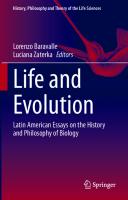Functions: New Essays in the Philosophy of Psychology and Biology 0199255814, 9780199255818
In explaining aspects of the natural world, including the aspects of mind, scientists have frequently used the concept o
264 71 31MB
English Pages 458 [459] Year 2002
Acknowledgments
Contents
Introduction
Part One History of teleology and functional explanations: From Socrates to Darwin and beyond
Chapt 1 Platonic and Aristotelian roots of teleological arguments Andre Ariew
Chapt 2 Evolutionary biology and teleological thinking Michael Ruse
Part Two Analysis: Functional explanations today
Chapt 3 A rebuttal on functions Christopher Boorse
Chapt 4 Biofunctions: Two paradigms Ruth Garrett Millikan
Chapt 5 On the normativity of functions Valerie Gray Hardcastle
Chapt 6 Neoteleology Robert Cummings
Chapt 7 Functional organization, Analogy, and inference William Wimsatt
Chapt 8 Function and design revisited David Buller
Chapt 9 The continuing usefulness account of proper function Peter Schwartz
Part Three Teleosemantics
Chapt 10 Pagan teleology: Adaptational role and the philosophy of mind Mark Perlman
Chapt 11 Indeterminacy of function attributes Berent Eng
Chapt 12 Brentano's chestnuts Denis Walsh
Part four Methodological issues
Chapt 13 Human rationality and the unique origin constraint Mohan Matthen
Chapt 14 Real traits real functions Colin Allen
Chapt 15 Types of traits: The importance of functional homologues Karen Neander
Biographies
Index
Recommend Papers

- Author / Uploaded
- Andre Ariew (editor)
File loading please wait...
Citation preview
7■
9 p-—ca = i„ the reabsorbtion of
XSS*'-'-'-^^SX)of»»“S"a'deW'0’”
^.edification (by natural se as a remnant and meIn other words, iKOTtsaKdenveJa„d„wJ;ficJ(n,mlhCuaUs.>( mental pattern. 1 dst): Organi H (evolution’
better explains
of
H (creationist). Each p Let us take stock of the impor^
independent act of creation.
Darwin’s answer to Paley’s argument for his Anstotehan teleology is an entirely □ether. Platonic teleo vestigial and odd arrangements’ suggests that different sort. EvidenCderived from a purposeful act of creation but rather oroanic traits are not modified from the traits of their ancestors organic traits are der^ is> Darwin replaces the hand of creation with 'a nowntt’1'0”’1
Ideological ‘force’! I see remnants of two sorts of
How is„n,r«n. The key to seeing both is within Darwin's conteleologV ' ’ i0„, Which can be summed up as follows: as a result of cent ol na,uta afferent heritable abilities striving t0 survive and individuals P«^ranments, comes an explanation for changes tn trait reproduce in 10."Lal,ons through time. Trans become prevalent in popula°‘S are useful to orgamsms m then struggle to survive. »»“ bKi"; ,Xl«le°* 15 P"S"f", thT,8h W« that an items Aristotle's * taiued in terms of ns usefulness (Le„„ox "
-ss imman
3. Ten Leading Objections I shall now answer ten of what seem to me the dozen best challenges to a GGC account of function. Although some of these objections were posed against other types of analysis, since they affect a GGC account equally, I will reply. Most of them can apply to all GGC analyses, and often S&R analyses too. But some are specific objections to my own statistical species-relative account of biomedical normality. 3.1. Arbitrary, Evaluative, or Circular Goal-Choice
Both Melander and Schaffner charge that the GGC approach has no naturalis tic way to identity the goals of organisms, but instead requires the theorist to choose them arbitrarily or evaluatively. Melander (1997: 32-4), adapting Nagel’s example, imagines that a person’s kidneys and muscles reset the target they maintain for blood water content at Similarly, Neander (forthcoming: 53 n. 13) says: ‘Since there is no selection without varia tion, a trail that has no competition will not be selected for anything in the future (until an alter native allele arises)’. Millikan’s argument (1989fc 174) that Bigelow and Pargetter’s account is incoherent is, however, unconvincing. 17 Thanks to Michael Rea for this concise summan’.




![Uric Acid: Biology, Functions and Diseases: Biology, Functions and Diseases [1 ed.]
9781621008057, 9781621007623](https://ebin.pub/img/200x200/uric-acid-biology-functions-and-diseases-biology-functions-and-diseases-1nbsped-9781621008057-9781621007623.jpg)


![Essays in the History and Philosophy of Science [1.0]](https://ebin.pub/img/200x200/essays-in-the-history-and-philosophy-of-science-10.jpg)

